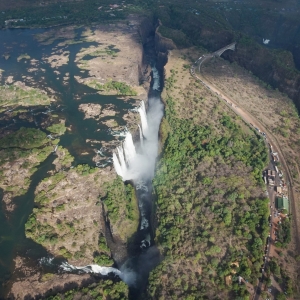Federal Water Tap, December 23: Budget, Defense Spending Bills Include Rural Water Increase, PFAS Provisions
The Rundown
President Trump signs a budget agreement and a Defense authorization bill. The Interior Department tells a New Mexico group that, after years of missed deadlines, it will not provide funds for a Gila River diversion. The EPA releases guidance for cleaning up PFAS in groundwater. Water bills introduced in Congress deal with Indian water rights settlements and drinking water affordability. An inspector general’s report finds a DOE contractor is not properly auditing contracts at a $16 billion hazardous waste treatment facility at Hanford. The EPA extends the public comment period for proposed Lead and Copper Rule revisions, and approves Denver Water’s lead pipe replacement program. The Interior secretary says the department will assess operating rules for Colorado River reservoirs. And lastly, a California senator urges compromise in the state’s water battles while a New York senator calls for more dam safety funding.
“I am deeply worried that we are on a disastrous course for California’s water management that will harm both California’s communities and its environment. To avoid this outcome, I urge California and the Department of the Interior to make every effort to develop consistent standards for coordinated operations of the Central Valley and State Water Projects in order to meet both parties’ responsibilities under the federal and state Endangered Species Acts.” — Sen. Dianne Feinstein (D-CA) in a letter to Gavin Newsom, governor of California, and David Bernhardt, secretary of the Interior. Feinstein sought compromise in disagreements about how much of the state’s water should remain in rivers rather than being sent to farms and cities.
In context: Gov. Newsom’s Threat to Sue Trump Threatens to Upends Peace Talks on California’s Water Wars
By the Numbers
64,000: Estimated number of privately owned lead service lines in Denver. Under an agreement with the EPA, the city’s water utility has agreed replace all the lead lines within 15 years. Denver Water opted for pipe replacements instead of changing the chemical mix it uses to minimize corrosion. The utility did not want to increase the amount of phosphates that are discharged into the South Platte River. While homes are waiting for a pipe replacement, Denver Water will provide water filters and spare cartridges. The program will be reviewed after three years. (U.S. Environmental Protection Agency)
$60 million: Federal funding that will be withheld from a proposed project in southern New Mexico to divert water from the Gila River. After years of deliberations, attempts by a New Mexico organization to select a diversion project have failed to make any progress, according to a letter from the Interior Department. “Even today, a feasible project with necessary funding and contractual commitments has not been identified to enable project success,” stated Tim Petty, assistant secretary for water and science. The department will not extend funds that were made available from a 2004 act of Congress. (Silver City Daily Press)
In context: Gila River Diversion Pits New West Vs Old
News Briefs
2020 Budget Deal
President Trump signed a bill that funds the federal government through September 2020. The budget deal includes increases to a number of water programs:
- $9 billion for the EPA, an increase of $208 million over 2019.
- $1.45 billion for loans to rural communities for water and wastewater projects. It’s an increase of $250 million over 2019.
- $2.77 billion for the Clean Water and Drinking Water state revolving funds. No change from 2019.
- $65 million in grants for salmon recovery and conservation programs in the western states and tribal territories.
- $206 million for water storage, recycling, and related infrastructure in California.
- $495 million for the Land and Water Conservation Fund, an increase of $60 million.
Defense Spending Bill Signed…With PFAS and Climate Provisions
President Trump also signed the National Defense Authorization Act.
The annual military spending bill included more than a dozen sections related to PFAS chemicals. The bill sets a timetable for phasing out the use of toxic firefighting foams at military bases. It orders the U.S. Geological Survey to conduct nationwide testing of rivers, lakes, groundwater, and wetlands for PFAS chemicals. It also requires companies to report PFAS discharges to air, land, and water as part of the Toxics Release Inventory.
In addition, the bill establishes a National Emerging Contaminant Research Initiative within the White House Office of Science and Technology Policy. Emerging contaminants are defined as those without a national drinking water standard.
Certain more controversial PFAS items were left out: how to handle the chemicals under the federal Superfund law and the Safe Drinking Water Act.
The bill also addresses climate risks at military bases. In planning and designing new construction projects, future sea-level rise projections will be taken into account. Military installations will be required to assess risks from extreme weather and develop plans to address the risks.
Gillibrand Asks for More Dam Safety Funding
Sen. Kirsten Gillibrand (D-NY) asked the leadership of the Environment and Public Works Committee to increase funding to repair aging dams that pose a safety risk.
In her letter, Gillibrand requested full funding for a dam-repair grant program that was authorized in 2016.
In context: At Least 1,680 Dams across the U.S. Pose Potential Risk
Water Bills in Congress
- A bill to permanently authorize a fund to pay for Indian water rights settlements moved to the full Senate for consideration.
- Sen. John Tester (D-MT) introduced a bill to settle water rights claims with the Fort Belknap Indian Community. The bill would authorize $630 million for water infrastructure and economic development in Fort Belknap. Tester and Sen. Steve Daines (R-MT) teamed up earlier this month to introduce a water rights settlement for the Confederated Salish and Kootenai Tribes.
- The Massachusetts delegation, all Democrats, introduced the Affordable Safe Drinking Water Act. The bill would extend the repayment period to 50 years or more for water infrastructure loans from the state revolving funds. It also allows for revolving funds to pay for PFAS and lead filtration systems at individual buildings, such as schools and community centers.
PFAS Groundwater Cleanup Standards
The EPA took another step in its self-proclaimed PFAS action plan by publishing standards to guide the cleanup of groundwater contaminated with the chemicals.
The guidance sets a “screening level” of 40 parts per trillion. A screening level is used to determine whether additional evaluation should be undertaken.
If cleanup is required and no state or tribal standards exist, then the agency suggests 70 parts per trillion, the same level as its non-binding health advisory for drinking water.
Even though there are thousands of PFAS chemicals, the guidance applies to only the two most-studied: PFOA and PFOS.
Studies and Reports
Reclamation Releases Key Environmental Analysis of California Water Delivery Systems
The Bureau of Reclamation published a final environmental impact statement for the operation of state and federal water delivery systems.
The preferred alternative aims to maximize water exports to farms and cities south of the Sacramento-San Joaquin delta, as is the Trump administration’s goal.
A final decision on the operation of the systems will not be made before January 21, 2020.
DOE Contractor Fails Oversight Evaluation
The main contractor responsible for a $16.8 billion hazardous waste treatment facility at the Department of Energy’s Hanford site did not follow auditing procedures when handing out sub-contracts, according to an inspector general’s report.
Bechtel is the construction firm responsible for building a treatment facility for some 56 million gallons of waste stored at the former nuclear weapons production site. The waste is currently held in underground containers, roughly one third of which are leaking and contaminating groundwater. The treatment facility will turn the waste into a glass-like material.
The inspector general found that Bechtel audited only 23 out of 110 eligible sub-contracts. By not doing the audits, Bechtel risks passing on unauthorized costs to the Department of Energy, the report concludes.
On the Radar
Lead and Copper Rule Comment Extension
The EPA extended by 30 days the period to submit comments on proposed revisions to the Lead and Copper Rule. Comments are now due February 12.
Colorado River Report
David Bernhardt, the Interior secretary, announced that the Bureau of Reclamation will assess the effectiveness of current rules that guide operation of the two largest Colorado River reservoirs.
The rules were put in place in 2007 and are due for revision by 2026. The report will take a year to complete, he said.
Federal Water Tap is a weekly digest spotting trends in U.S. government water policy. To get more water news, follow Circle of Blue on Twitter and sign up for our newsletter.
Brett writes about agriculture, energy, infrastructure, and the politics and economics of water in the United States. He also writes the Federal Water Tap, Circle of Blue’s weekly digest of U.S. government water news. He is the winner of two Society of Environmental Journalists reporting awards, one of the top honors in American environmental journalism: first place for explanatory reporting for a series on septic system pollution in the United States(2016) and third place for beat reporting in a small market (2014). He received the Sierra Club’s Distinguished Service Award in 2018. Brett lives in Seattle, where he hikes the mountains and bakes pies. Contact Brett Walton





Leave a Reply
Want to join the discussion?Feel free to contribute!